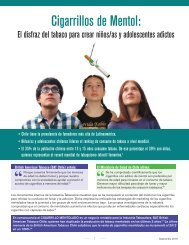Public health successes and missed opportunities
Public-health-successes-and-missed-opportunities-alcohol-mortality-19902014
Public-health-successes-and-missed-opportunities-alcohol-mortality-19902014
You also want an ePaper? Increase the reach of your titles
YUMPU automatically turns print PDFs into web optimized ePapers that Google loves.
<strong>Public</strong> <strong>health</strong> <strong>successes</strong> <strong>and</strong> <strong>missed</strong> <strong>opportunities</strong><br />
Fig. 14. Trends in per drinker per capita alcohol consumption for adult women in the WHO European Region<br />
<strong>and</strong> selected subregions, 1990–2014<br />
Litres of pure alcohol<br />
22<br />
20<br />
18<br />
16<br />
14<br />
12<br />
10<br />
8<br />
6<br />
EU<br />
Central-western EU<br />
Mediterranean<br />
South-eastern WHO<br />
European Region<br />
Central-eastern EU<br />
Eastern WHO<br />
European Region<br />
WHO<br />
European Region<br />
4<br />
1990<br />
1992<br />
1994<br />
1996<br />
1998<br />
2000<br />
2002<br />
2004<br />
2006<br />
2008<br />
2010<br />
2012<br />
2014<br />
More efforts should be undertaken to counter such developments by the respective countries <strong>and</strong> by the WHO European<br />
Region as a whole. Second, despite the overall decrease in alcohol consumption, the Region still has the highest levels<br />
of consumption in the world. From a broader public <strong>health</strong> perspective, the average consumption per adult in the WHO<br />
European Region is high, with comparatively more risks associated with drinking as compared with other voluntary<br />
activities or other forms of substance use (68–70). This argues for a special effort to reduce alcohol consumption by well<br />
beyond 10% in the European Region.<br />
More general conclusions will be given after describing the <strong>health</strong> burden attributable to alcohol consumption.<br />
Comparisons between the WHO European Region <strong>and</strong> other<br />
WHO regions<br />
Fig. 15 <strong>and</strong> 16 show the main components of per capita consumption in 1990 <strong>and</strong> the percentage changes in the 25 years<br />
by WHO region (for the composition of WHO regions by countries, see Web Appendix 7).<br />
The following general statements can be made:<br />
• Adult per capita alcohol consumption in WHO regions increased by about 10% over the past 25 years, <strong>and</strong> the rank order<br />
of regions remained stable, with the WHO European Region consuming the most alcohol, followed by the Region of the<br />
Americas, Western Pacific Region, African Region, South-East Asia Region <strong>and</strong> Eastern Mediterranean Region.<br />
• Over this time period, the two regions with the highest consumption, the WHO European Region <strong>and</strong> the Americas,<br />
decreased their consumption by 11% <strong>and</strong> 1%, respectively.<br />
• Most of the increase in consumption was in the Asian regions, fuelled by marked increases in consumption in China<br />
(Western Pacific Region; see (71)) <strong>and</strong> India (South-East Asia Region; for more details, see (72)). The African Region<br />
also increased its alcohol consumption markedly (for more details on the WHO African Region, see (73)).<br />
The overall trends are not only heterogeneous between WHO regions, but also within regions between countries. Fig. 17<br />
gives an overview of this variability.<br />
14




